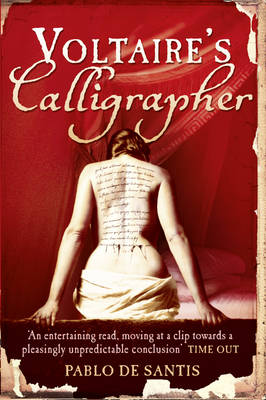
EURO CRIME
Reviews

de Santis, Pablo - 'Voltaire's Calligrapher' (translated by Lisa Carter)
Paperback: 224 pages (Sep. 2010) Publisher: Harper ISBN: 0007269056
Argentinian author Pablo de Santis has set both of his books (that are available in English) in France. The first, THE PARIS ENIGMA takes place in 1889 but in VOLTAIRE'S CALLIGRAPHER he goes back even further, to thirty years before the start of the Reign of Terror.
You know when you read the first line: I arrived in this port with very few belongings: four shirts, my calligraphy implements, and a heart in a glass jar that you're in for an unusual ride. Despite its literary title and arty (but relevant) cover this is a quick read and one that conjures imagery that lingers in the mind.
The narrator of this short tale is calligrapher Dalessius who at the opening of the book has fled France and ended up in a Spanish speaking port at the other side of the world. He then tells the reader how he has ended up there.
As an orphan he'd been living with his uncle. His uncle saw his talent for letters and sent him to calligraphy school. Dalessius was good at his work but being young, prone to trying new techniques and an experimentation with disappearing ink led to jail time. On his release the only work he could find was for Voltaire, living on the French/Swiss border.
Dalessius's journey to to Voltaire involved him travelling on his uncle's Night Mail (carriages which repatriate the dead to their place of birth for burial) where he fell in love with a corpse. However this was not the last time he'd see her. To say how would be to give a bit of the plot away, even though it's unfortunately alluded to on the back of the book, giving some of the surprise away.
Dalessius's employment with Voltaire sees him spying in Toulouse and then in Paris where the people he meets range from a friendly executioner to an unfriendly scientist, from Bishops to booksellers and finally a legendary calligrapher. The plot revolves around a religious power struggle but for me the strongest part of the book is the evocation of the places and the tense atmosphere of the times. There are some unusual and memorable characters and the elegant narrative is scattered with cynical humour. Beautifully translated by Lisa Carter this is a very odd story, but with its mish-mash of mystery, history and science-fiction, one that I couldn't put it down.
Karen Meek, England
November 2010
More European crime fiction reviews can be found on the Reviews page.